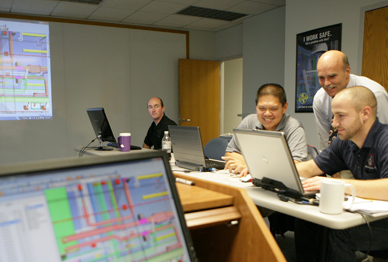‘Inside the walls of the company, we’re going through a culture shift’
CHICAGO – If you’re making a list of the top five things asset owners want to discuss as they’re interviewing design-build firms, BIM has to be on there somewhere. At least that’s been Kevin Bredeson’s experience. As director of virtual construction for Pepper Illinois, part of the $1.5 billion Pepper Construction, he oversees all things BIM and is brought in to help define for potential clients what the company’s core BIM focus is and, more simply, “what’s the value added to the project?”
However, BIM still doesn’t mean the same thing to everyone. “In the industry, most people think of BIM as let’s start modeling and the data capture is done more traditionally,” Bredeson said recently in an interview with SPAR. “We’re really trying to change that mindset. We have a menu of services that we’ve built, and say laser scanning is definitely one of those. We’re definitely promoting it and there are others that are promoting it as well.”
Why? Efficiency, cost-savings, quality control, “we’re just at the start of where all the value is going to be provided by using the data,” Bredeson said.
After renting laser scanning services and doing lunch-and-learns with Precision Midwest starting roughly a year ago, and having Pepper’s internal survey team shadow those scanning efforts and get on-the-job training, the company was convinced enough of laser scanning’s benefits that it moved just after the holidays to acquire a Trimble CX laser scanner of its own. Pepper is an Autodesk shop, but also uses Google SketchUp for some mock-up work and has piloted Tekla.
Like others, Pepper has had some issues with working directly with PointClouds in Revit, but “the way we’ve circumvented that is by working inside of RealWorks,” Bredeson said. “We do the solids modeling inside of that and then bring that over and make sure we have reference and control to that we can tie it all together.”
Now, armed with some internal case-study data about speed to completion, much of Bredeson’s job is spreading word about the technology throughout the company. “The biggest thing is that people don’t even know the technology exists,” he said. “We have project managers that are pushed to their limits. We’re still in a bad economic forecast. They’re still getting margins that are squeezed to a degree that hasn’t been seen before. We’re just trying to make great business decisions – the project managers don’t have a lot of time for looking at technology trends, so they look to people like me to make them aware.”
“If it’s a complex assembly,” he said, “or a complex existing condition where a typical survey team wouldn’t provide value, we’re promoting it there.” At SPAR International in April, Bredeson will present a case study he’s still in the course of completing that involved demolition and renovation of an 18,000-square-foot space in a downtown Chicago skyscraper. Pepper was able to go from laser scanning to a fully developed Navisworks presentation of the space in a week and a half. On a job where there was very little time for shutdown, and everything needed to be brought up to the work space in an 8’x8’ elevator, the ability to plan that the as-built documentation allowed was crucial, Bredeson said.
The contractors were able “to start planning their routing and where they needed to be and where they needed to go,” plus check the accuracy of the as-built documents coming from the architect and coordinate work with other contractors.
Bredeson said he’s constantly saying, “Hey, this technology is out there, and laser scanning can capture all this information at a very fast speed, with more information than you’d ever want to consume. And if you think you have a project like this, then we should talk.” Pepper does have a business operation group whose sole purpose is renovation work, and Bredeson is working with that group leader to find more opportunities for leveraging the technology.
“The awareness is the biggest thing,” he said, “and then after that it’s: ‘What does this cost and what are the benefits of this to me and the owner?’”
Bredeson said the company is obviously still developing new best practices for using the laser scanner and finding new uses. They’re using it to create as-built documentation during construction for quality checks, making sure they can meet increasingly tightened tolerances. “I would say we’re absolutely going to look for ways to do prefab,” he said. “Our contractors are used to doing a lot of these prefit assemblies.”
But, in the end, laser scanning is still just part of an overall BIM education that Pepper is going through. “Inside the walls of the company, we’re going through a culture shift,” Bredeson said. “Education and training and awareness are three big components of that. We’re training project executives, project managers, everyone on the benefits of what we’re able to do, both with starting from scratch on a ground-up, or if we have renovation work.”






